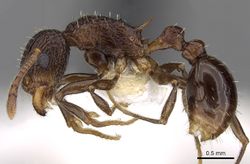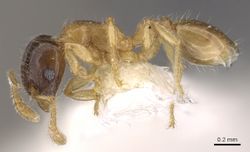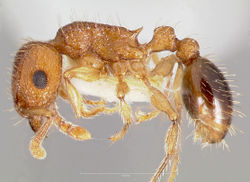Key to Afrotropical Tetramorium species groups
This key is based on Bolton 1980[1] adding the decem group following Hita Garcia and Fisher (2014)[2], and the species on the former genus Rhoptromyrmex under the globulinode group
The species belonging to the former Triglyphothrix genus are redistributed into other groups (Bolton, 1985[3]) was synonymyzed with Tetramorium and their species groups have been retained here except for two species. Species belonging to this non-group (!) can be distinguished by the presence of abundant bifid or triphid queate distributed all over the body.
Although Bolton (1980) consistently defined the species groups, some species belong to a species group but are best identified in another. The full list for these species is:
| Species | Belongs to group | Keyed in | Reason |
|---|---|---|---|
| Tetramorium flabellum | flabellum | ericae, osiris, inezulae, gabonensis | Branched pilosity |
| Tetramorium plumosum | grassii | ericae, osiris, inezulae, gabonensis | Branched pilosity |
| Tetramorium rothschildi | solidum | ericae, osiris, inezulae, gabonensis | Branched pilosity |
| Tetramorium pauper | simillimum | shiloense | Small eyes |
You may also be interested in:
1
- Branched hairs present on some or all of the surfaces of head, mesosoma, petiole, postpetiole and gaster ..... groups ericae, osiris, inezulae, gabonense (Key to species)
- Branched hairs absent .....2
2
- Head heart shaped in full-face view. Ventral margin of petiole convex and keel-like. Anterior clypeal margin strongly arcuate and prominent. Eyes behind midlenght of sides of head ..... globulinode group (Key to species)
- Head not heart shaped in full-face view. Ventral margin of petiole never convex and keel-like. Anterior clypeal margin not strongly convex nor prominent. Eyes only rarely behind midlenght of sides of head .....3
3
return to couplet .....2
- Antennae with 10 segments => decem group (Key to species)
- Antennae with 11 or 12 segments .....4
4
return to couplet .....3
- Antennae with 11 segments .....5
- Antennae with 12 segments .....7
5
return to couplet .....4
- Petiole squamiform or represented in profile by a high, narrow node ….. weitzeckeri group (Key to species)
- Petiole strongly nodiform .....6
6
return to couplet .....5
- Dorsal (outer) surface of hind tibiae only with fine pubescence. Hairs on first gastral tergite directed towards midline, at least in part …. angulinode group (Key to species)
- Dorsal (outer) surface of hind tibiae only with long projecting hairs. Hairs on first gastral tergite not directed towards midline….. tortuosum group (Key to species)
7
return to couplet .....4
- SI (scape index: SL/HW x 100) 100 or more .....8
- SI < 100 .....12
8
return to couplet .....7
- Frontal carinae extending back well beyond the level of the posterior margins of the eye .....9
- Frontal carinae ending at or in front the level of the eyes .....10
9
return to couplet .....8
- Maximum diameter of eye 0,25 x HW at minimum, usually greater. Longest row of facets with at least 9 ommatidia. Petiole node high and quite narrow in profile …..setigerum group (in part) (Key to species)
- Maximum diameter of eye 0,24 x HW at maximum, usually smaller. Longest row of facets with 7-8 ommatidia. Petiole node long and low in profile …..flabellum group (in part) (Key to species)
10
return to couplet .....8
- Petiole node in profile long and low, in dorsal view usually longer than broad.....11
- Petiole node in profile high and narrow, in dorsal view distinctly broader than long …..aculeatum group (Key to species)
11
return to couplet .....10
- Lateral portions of clypeus prominent as a tooth or crest on each side in full face view. When viewed from above and behind, the lateral parts of the clypeus rise to a high peak in front of the antennal insertions and then slope steeply down towards the median portion of the clypeus …..sericeiventre group (Key to species)
- Lateral portions of clypeus not strongly modified as above …..setigerum group (part) (Key to species)
12
return to couplet .....7
- Eyes very small or minute. Maximum diameter < 0,17xHW, less than maximum width of scape. Commonly only 1-5 facets altogether, but always with 5 or less ommatidia in the longest row …..shilohense group (Key to species)
- Eyes larger. Maximum diameter >0,20xHW, greater than maximum width of scape, with more than 5 facets in the longest row .....13
13
return to couplet .....12
- Petiole, and sometimes also postpetiole, squamiform…..squaminode group (Key to species)
- Petiole not squamiform.....14
14
return to couplet .....13
- Lamellate appendage of sting spatulate or linear…..grassii group (Key to species)
All the species with strong frontal carinae reaching the occipital line (K. Gómez)
- Lamellate appendage of sting dentiform, triangular or pennant shaped .....15
15
return to couplet .....14
- Frontal carinae short, ending in front of the level of the posterior margins of the eyes .....16
- Frontal carinae long, reaching back well beyond the level of the posterior margins of the eyes, usually approaching or even reaching the occipital margin .....19
16
return to couplet .....15
- Either anterior clypeal margin with a broad deep indentation medially or ventral surface of head with ammochetae hairs present or both …..solidum group (Key to species)
- Anterior clypeal margin entire and ventral surface of head without ammochetae hairs .....17
17
return to couplet .....16
- Hairs on dorsal alitrunk and/or first gastral tergite short, stout, and blunt apically …..simillimum group (part) (Key to species)
- Hairs on dorsal alitrunk and/or first gastral tergite fine and acute apically, or hairs absent from both these surfaces .....18
18
return to couplet .....17
- Mandibles striate …..caespitum group. One species:Tetramorium nautarum
- Mandibles smooth …..convexum group (Key to species)
19
return to couplet .....15
- Anterior clypeal margin with a median notch or impression, even if small .....20
- Anterior clypeal margin entire, without a trace of median notch or impression .....24
20
return to couplet .....19
- Occipital region of head with a rugoreticulum …..bicarinatum group (Key to species)
- Occipital region of head at most with a few anastomoses, without a rugoreticulum .....21
21
return to couplet .....20
- Propodeum with a pair of small triangular teeth or denticles …..dumezi group (part) (Key to species)
- Propodeum with a pair of spines .....22
22
return to couplet .....21
- Dorsal surfaces of petiole and postpetiole unsculptured or at most with only vestigial traces of sculpture …..camerunense group (part) (Key to species)
- Dorsal surfaces of petiole, postpetiole or both distinctly sculptured .....23
23
return to couplet .....21
- Node of postpetiole in dorsal view longer than broad…..camerunense group (part) (Key to species)
Mandibles striate or smooth [K. Gómez]
- Node of postpetiole in dorsal view broader than long…..capense group (Key to species)
Mandibles striate [K. Gómez]
24
return to couplet .....19
- Propodeum armed with a pair of elongate spines .....25
- Propodeum at most with a pair of short, triangular teeth; sometimes only with a pair of denticles, most rarely unarmed .....28
25
return to couplet .....24
- Dorsal (outer) surface of hind tibiae with erect or suberect hairs or pubescence .....26
- Dorsal (outer) surface of hind tibiae without erect or suberect hairs or pubescence .....27
26
return to couplet .....25
- Occipital region of head with a rugoreticulum …..quadridentatum group (part) (Key to species)
- Occipital region of head without a rugoreticulum …..camerunense group (part) (Key to species)
27
return to couplet .....25
- Either the anterior and dorsal faces of the petiole node in profile meeting in a smooth curve without a developed anterodorsal angle, or the eyes large with maximum diameter >0,30 x HW …..quadridentatum group (part) (Key to species)
- Anterior and dorsal faces of the petiole node in profile meeting in an angle, a defined anterodorsal angle present. Eyes smaller< 0,26 x HW…..flabellum group (part) (Key to species)
28
return to couplet .....24
- Mandibles longitudinally striate and the anterior and dorsal faces of the petiole node meeting in a smooth continuous convexity, without an anterodorsal angle …..quadridentatum group (part) (Key to species)
- Mandibles smooth or striate. If the latter, then a distinct anterodorsal angle developed which separates anterior and dorsal faces of the petiole node .....29
29
return to couplet .....28
- Mandibles usually sculptured. Hairs on dorsal alitrunk short, stout and blunt when present; if absent, then the eyes large, maximum diameter > 0,29 x HW or more …..simillimum group (part) (Key to species)
- Mandibles usually smooth. Hairs on dorsal alitrunk fine and acute when present; if present, then eyes with maximum diameter < 0,29 x HW …..dumezi group (part) (Key to species)
References
- ↑ Bolton, B. 1980. The ant tribe Tetramoriini (Hymenoptera: Formicidae). The genus Tetramorium Mayr in the Ethiopian zoogeographical region. Bull. Br. Mus. (Nat. Hist.) Entomol. 40: 193-384.
- ↑ Hita Garcia, F.; Fisher, B. L. 2014a. The ant genus Tetramorium Mayr in the Afrotropical region (Hymenoptera, Formicidae, Myrmicinae): synonymisation of Decamorium Forel under Tetramorium, and taxonomic revision of the T. decem species group. ZooKeys 411:67-103. [2014-05-28]
- ↑ Bolton, B. 1985. The ant genus Triglyphothrix Forel a synonym of Tetramorium Mayr. (Hymenoptera: Formicidae). Journal of Natural History. 19: 243-248.







































